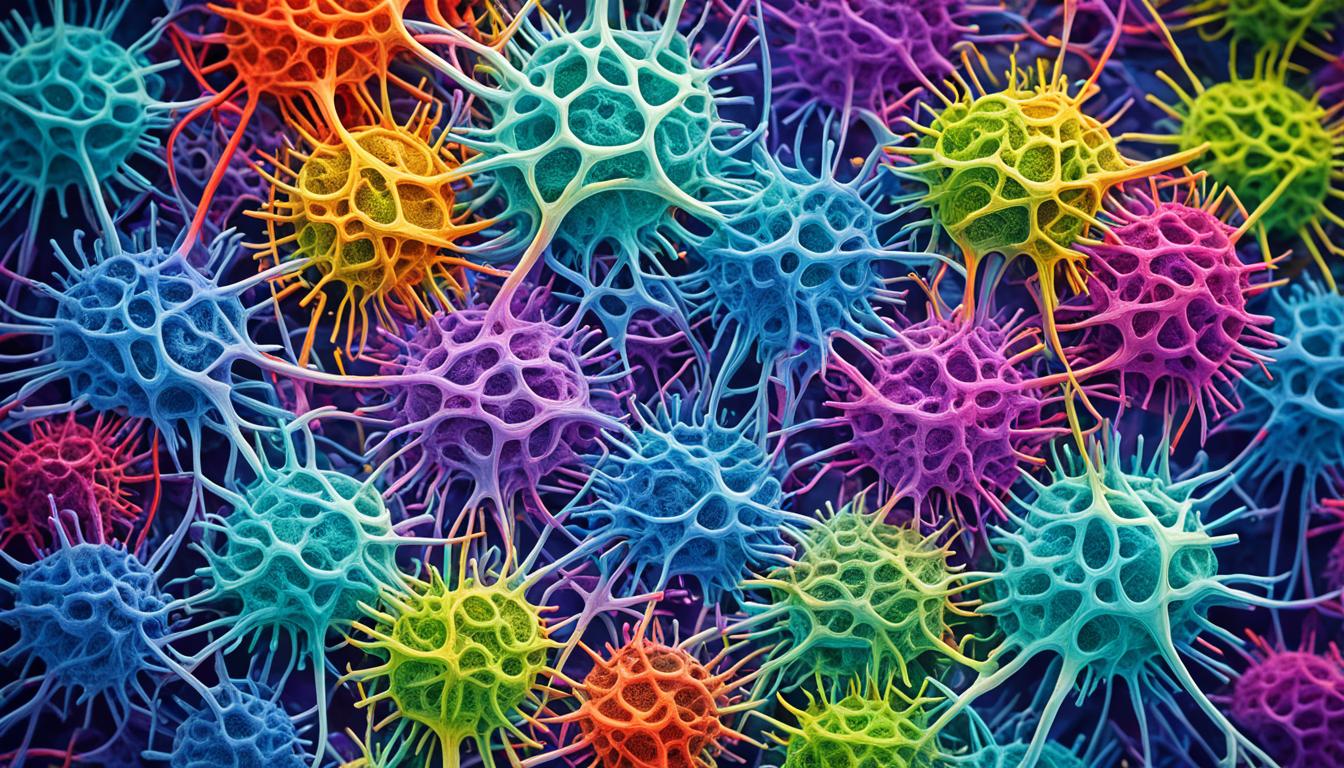Paraneoplastic syndromes of the nervous system are rare issues in cancer patients. They happen when the immune system harms the brain and nerves. This can lead to problems with moving, thinking, and feeling well.
Signs of these syndromes vary based on what part of the nervous system is under attack. They may include trouble walking, muscle coordination loss, or even seizures. These signs can really lower someone’s life quality and must receive quick medical check-up.
These syndromes most link with lung, ovary, breast, and blood, or lymph, tumors. Their arrival could mean there is a hidden cancer. Thus, seeing a doctor quickly when facing such symptoms is key.
Diagnosing these syndromes is tough because they are rare and look like other diseases. Doctors use tests to check for specific antibodies and cancer signs. This helps them pinpoint the issue.
To treat, the cancer and nerve damage should both be addressed. This often involves chemotherapy or radiation for the cancer. Then, therapies to calm the immune system offer help.
Severe cases might benefit from plasmapheresis, to clean the blood of bad antibodies. Doctors will also support symptom management. This improves the patient’s daily comfort and life quality.
However, research is looking into a newer solution: stem cell therapy. This treatment explores how stem cells could fix the damaged nerves. Though in its early phase, it brings hope for future treatments.
Key Takeaways:
- Paraneoplastic syndromes of the nervous system are rare conditions that can occur in individuals with cancer.
- This involves the immune system attacking parts of the nervous system, causing various problems.
- Issues can include trouble walking, muscle coordination loss, memory issues, vision changes, and seizures.
- These syndromes are often connected to lung, ovary, breast, testis, and lymphatic system cancers.
- Early diagnosis, quick treatment, and cancer management are crucial for these syndromes.
Symptoms and Types of Paraneoplastic Syndromes of the Nervous System
Paraneoplastic syndromes can show up in various ways, depending on which part of the nervous system is affected.
They often signal a hidden cancer. It’s important not to ignore these symptoms. Getting quick help is vital for a proper diagnosis and treatment.
Common symptoms include:
- Trouble walking
- Loss of muscle coordination
- Muscle weakness
- Trouble swallowing
- Slurred speech
- Memory loss
- Vision changes
- Seizures
- Hallucinations
Paraneoplastic syndromes are categorized by the area they affect. Here are a few types:
| Type | Description |
|---|---|
| Cerebellar Degeneration | Affects the cerebellum, causing issues with coordination and balance. |
| Limbic Encephalitis | Involves inflammation of the limbic system and can result in memory loss and behavioral changes. |
| Encephalomyelitis | Affects both the brain and spinal cord, leading to neurological symptoms. |
| Opsoclonus-Myoclonus | Causes involuntary eye movements (opsoclonus) and muscle jerks (myoclonus). |
| Stiff Person Syndrome | Results in stiffness and spasms of the muscles, particularly the trunk. |
| Myelopathy | Affects the spinal cord, leading to motor and sensory disturbances. |
| Lambert-Eaton Myasthenic Syndrome | Impairs the communication between nerves and muscles, causing muscle weakness. |
| Myasthenia Gravis | Produces muscle weakness and fatigue due to an autoimmune attack on the neuromuscular junction. |
| Neuromyotonia | Results in continuous muscle twitching and cramping. |
| Peripheral Neuropathy | Affects the peripheral nerves, leading to numbness, tingling, and weakness in the extremities. |
| Dysautonomia | Disrupts the automatic functions of the nervous system, such as heart rate and blood pressure regulation. |
If you notice these symptoms, it’s vital to get help quickly. Talk to a doctor for a full check-up.
Diagnosis, Treatment, and Outlook for Paraneoplastic Syndromes of the Nervous System
Diagnosing paraneoplastic syndromes is a challenge. The symptoms often look like other health issues. Doctors use many tests to find out what’s going on. These can include checking the patient, using images, doing blood tests for specific antibodies, and looking for cancer markers. When they know what it is, treating the cancer becomes the top priority.
For cancer treatment, things like chemotherapy or radiation might be needed. But, there are other ways to help. Immunotherapy can calm down the body’s attack on the nerves. Plasmapheresis is also an option. This is when certain bad antibodies are removed from the blood.
Supportive care is very important too. It helps to ease symptoms and make the patient’s life better.
The outlook for these syndromes changes based on the cancer’s type and stage. Finding and treating them early is key. This can help stop more nerve damage.
Thankfully, new ways to treat these syndromes are being studied. Stem cell therapy, for example, might offer better treatments in the future. This gives hope for a brighter future for those affected.

